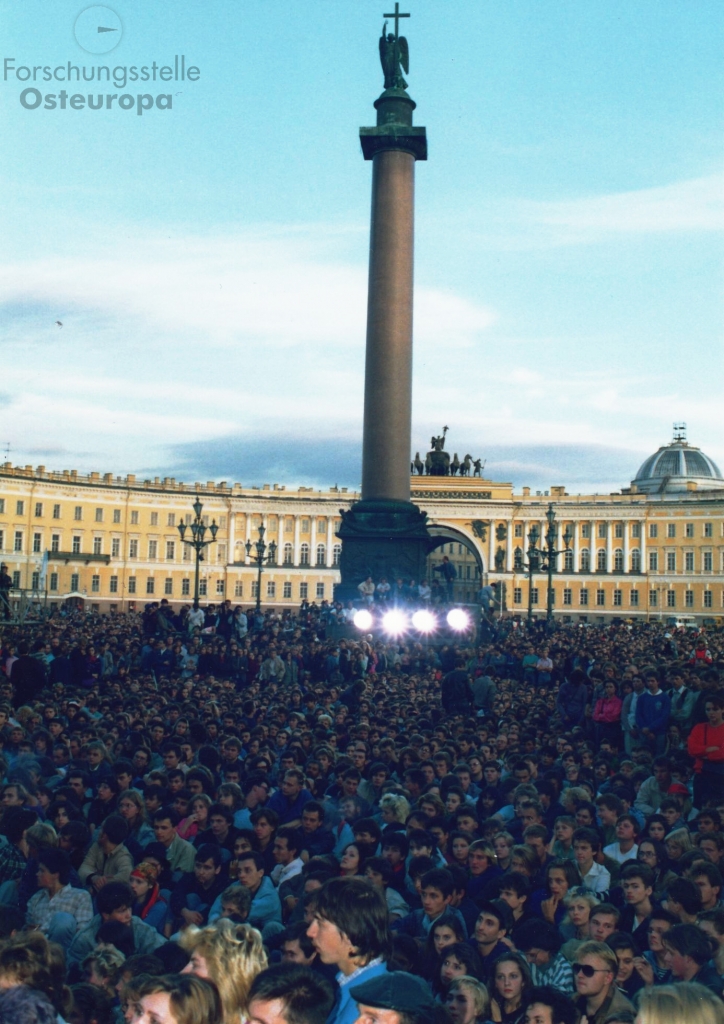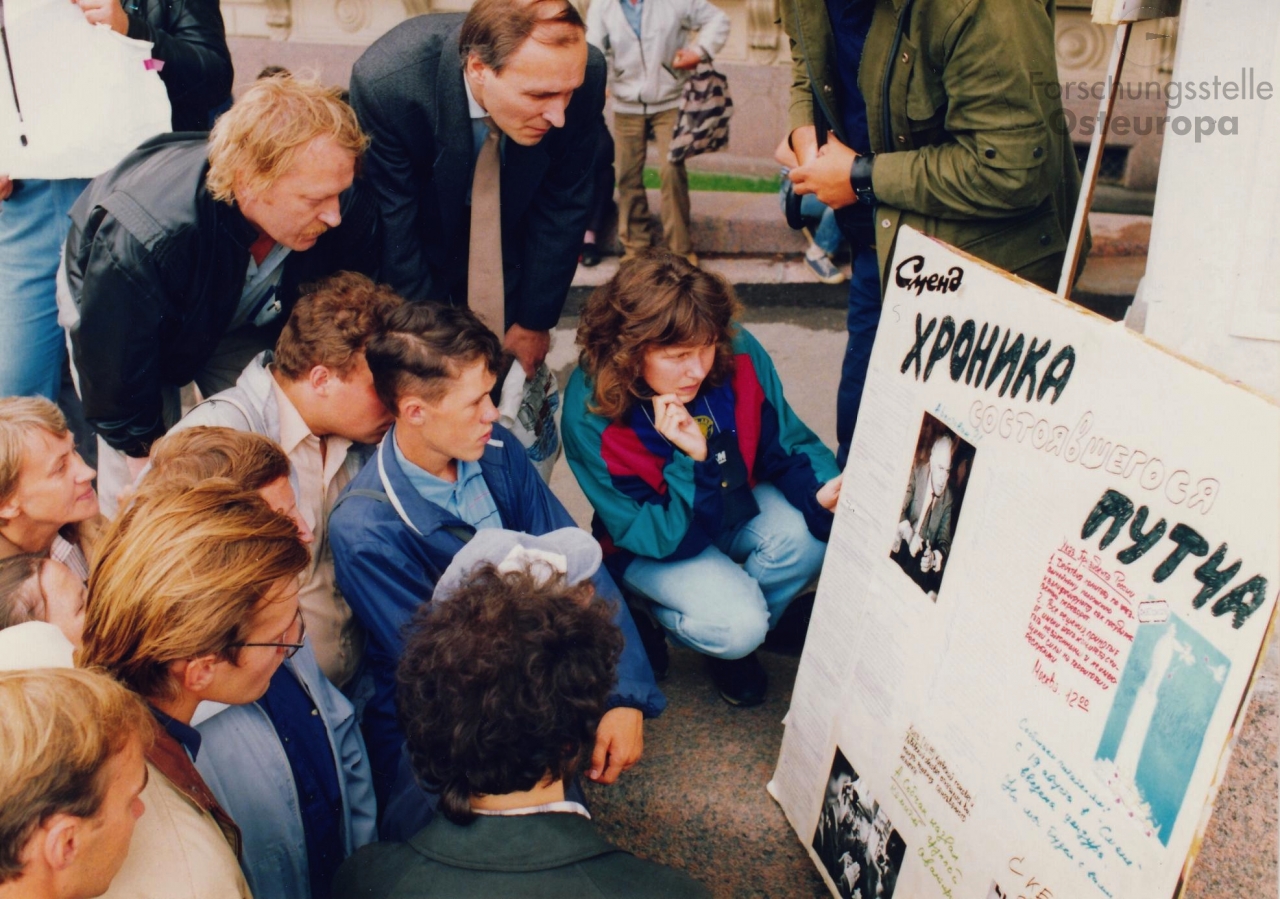Odesa-Tage 2025
Kolloquiumsvortrag
18:15 Uhr, / Zoom
Svetlana Erpyleva (Bremen) | When the War Is Next Door. How the Residents of a Russian Borderline Region Experience and Interpret the Russo -Ukrainian War
Buchvorstellung
18:00 Uhr
Annette Schuhmann
Wir sind anders! Wie die DDR Frauen bis heute prägt.
Buchvorstellung
18:00 Uhr
An Evening with Maksym Butkevych
Europapunkt
18:00 Uhr
An Evening with Maksym Butkevych
Europapunkt
Wissenswertes
Putsch Days
Commemorating the 30th anniversary of the coup d’état and its failure


Protestors gathering in Leningrad, August 1991. Archive of the Research Centre for East European Studies. Photos: Vladimir and Alexander Vesnёnok.
On 19-21 August 1991, thirty years ago, a political event took place in the USSR which soon was described by the short word "putsch". It refers to the history of military coups in democracies and in Russia had always been associated with the actions of right-wing radicals, or more precisely with "fascists". The putsch, however, was staged by leaders of the Communist Party which nominally followed the tradition of fighting against fascism. By calling them "putschists", the advocates of democratic reforms in the USSR were demonstrating, albeit unconsciously, how much Soviet society had changed in the post-war decades.
Formally, the putsch was organized by that circle of top officials who were to lose their positions as a result of signing the so-called Union Treaty. Through this treaty the USSR was transformed into a real federation of states (except for the Baltic countries, Azerbaijan, and Georgia), and the role of the "Union centre" was significantly weakened. The "putchists" – who included the vice president, prime minister, chairman of the Supreme Soviet of the USSR, defence ministers, minister of the interior, and the head of the KGB – secretly organized an unconstitutional "State Committee for the State of Emergency" (GKChP) which took responsibility for the 19 August 1991 coup. They succeeded in thwarting the signing of the treaty, but not in preserving their positions. Ironically, they gave a powerful push to the dissolution of the USSR, although they sincerely tried to prevent such a development.
For the main forces of the army and the KGB the order by the committee to occupy the capital cities (above all Moscow) came as a surprise. And so were the mass protests of the population. In Moscow, according to various estimates (and at different times) between 50,000 and 170,000 people took part in the defence of the White House, which served as the seat of the Supreme soviet of Russia. In Leningrad, a protest rally on August 20 brought together several hundred thousand people, too, as a result of which the GKChP refused to allow troops into the city. The photos of the protests in Leningrad, some of which you can see here, were taken by the engineer Vladimir Vesnёnok, born 1937, and his son Alexander. Vladimir emigrated to Germany soon after the events, settling in Bremen permanently in 1994. His photos were among the first documents he contributed to the archives of the Research Centre.
The decisive events took place on the night of August 20 to 21 when three White House defenders were killed during a menacing military action. The KGB units finally abandoned the assault. It motivated this by the high number of potential casualties. At 9 a.m. on August 21, the members of the GKChP gave the order to withdraw their troops and subsequently flew to Mikhail Gorbachev whom they had detained in the Foros residence on the Crimean Peninsula.
All in all, the most important factors in defeating the GKChP on August 19-21 were the determination of Boris Yeltsin who was not afraid to challenge the whole of the imperial bureaucracy and become the leader of the protest, Mikhail Gorbachev who was not anxious to save the USSR at any cost, and the readiness of the democratic opposition in Moscow and Leningrad to mobilize and risk their lives for freedom. The author of this text was happy to take part in this as much as he could.
Nikolay Mitrokhin
Further reading
Gordon M. Hahn: Russia’s Revolution from Above: Reform, Transition, and Revolution in the Fall of the Soviet Communist Regime, 1985-2000, New Brunswick 2002.
Alexei Yurchak: Everything Was Forever, Until It Was No More: The Last Soviet Generation, Princeton 2006.
Chris Miller: The Struggle to Save the Soviet Economy: Mikhail Gorbachev and the Collapse of the USSR, Chapel Hill 2016.
Nikolay Mitrokhin is research fellow at the Research Centre for East European Studies at the University of Bremen. He published extensively on the topic of nationalism and religion in (post-)Soviet politics. His forthcoming books will be an analysis of the Central Committee of the Communist Party, 1953-1985 and Soviet economic policy, 1965-1989.
Länder-Analysen
Die Länder-Analysen bieten regelmäßig kompetente Einschätzungen aktueller politischer, wirtschaftlicher, sozialer und kultureller Entwicklungen in Mittel- und Osteuropa sowie Zentralasien. Alle Länder-Analysen können kostenlos abonniert werden und sind online archiviert.
» Länder-Analysen
» Eastern Europe - Analytical Digests
» Länder-Analysen
» Eastern Europe - Analytical Digests
Discuss Data
Archiving, sharing and discussing research data on Eastern Europe, South Caucasus and Central AsiaOnline-Dossiers zu
» Erdgashandel
» Hier spricht das Archiv
» Russian street art against war
» Dissens in der UdSSR
» Duma-Debatten
» 20 Jahre Putin
» Protest in Russland
» Annexion der Krim
» sowjetischem Truppenabzug aus der DDR
» Mauerfall 1989

